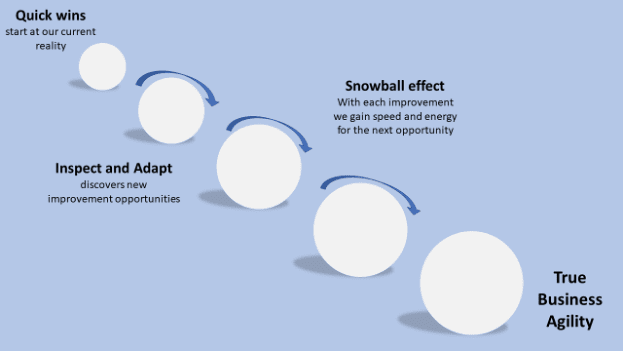How to use the gap between where you are and where you want to be
This post is part of the ongoing Practice Makes Permanent blog series. Read the first post here.
OK, so your Lean-Agile transformation is stalling. It’s not delivering the increased value and reduced delivery times you expected. Your teams are struggling and perhaps updating their resumes. You thought that implementing the Scaled Agile Framework® (SAFe®) would bring you these outcomes, but you’ve discovered you’re not using all Ten Critical Success Factors of SAFe. Perhaps you’ve discovered that you’re not actually implementing SAFe correctly as you intended, which means you’re probably not gaining the full value of what the Framework has to offer. The key to taking full advantage of this realization is to be encouraged rather than discouraged. We can’t improve until we see the improvements that are needed. The purpose of this article is to help you see that these discoveries should be cause for celebration, not concern.
One of my favorite books (and authors) is Peter Senge’s The Fifth Discipline. In his book, Peter describes the concept of creative tension as ”the tension between vision and reality.” It’s the concept of discovering the gap between where you are and where you want to be and using that gap as energy to make improvements. Think of it as a transformational snowball effect.
SAFe guidance depicts the perfect scenario where an organization exemplifies all seven core competencies, delivering high quality and accurate value to customers, and having the kind of culture and work environment that makes it a great place to work. Then we look at the current reality and realize we have a long way to go to reach this nirvana state of business agility.
Sometimes that gap seems insurmountable, unachievable, and perhaps just unrealistic. As we identify that first improvement opportunity and implement that first improvement effort, we start to see some excitement and engagement. We’re still a long way from that nirvana view, but we’re starting to make progress. And that creates more energy for the next effort. So, we take on the next improvement effort, and there seems to be just a bit more engagement and hope that we can move forward. And that’s where we start to see the snowball effect of relentless improvement.

For each improvement we make, we gain more energy, engagement, and willingness to change. And we start to go faster. And faster. And faster. And now, that relentless improvement pillar seems to make more sense, and in fact, becomes part of our DNA. As Peter Senge stated, “The most effective people are those who can ‘hold’ their vision while remaining committed to seeing current reality clearly.”
Positive change is contagious. It brings excitement and hope to the organization. That energy must start somewhere. So, as Taichi Ohno said, “If you are going to do Kaizen continuously … you’ve got to assume that things are a mess. Too many people just assume that things are all right the way they are … If you assume that things are all right the way they are, you can’t do Kaizen. So, change something!”
My point is to change something with a huge grin on your face because you can see the snowball effect of creative tension pulling you upward.

So, when you see that gap between your current reality and where you want to be, you should view it as an opportunity, not a negative situation. In other words, you should view every improvement opportunity with excitement and anticipation of where you can go next on the journey toward business agility.
As change agents, we’ve learned that empathy along the transformation journey is vital. We know how hard it is, so we fully understand why you skipped some of the steps. But now is the time to restart or renew that journey. In subsequent posts, we will talk about specific activities and components we can use the creative tension approach to jump-start a Lean-Agile transformation. The goal of this series is to help you find the next opportunity to accelerate that snowball effect in your transformation.
Check back soon for the next post in the series.
About Dwayne Stroman

Dwayne is an Enterprise Transformation Coach and Trainer and SAFe® Program Consultant Trainer (SPCT) with more than 20 years of experience. He is ultra-passionate about helping large organizations learn how to build the right products and deliver optimal value through learning and customer validation. Dwayne uses his SPCT role to help several Fortune 100 companies, as well as many growing companies in finance, retail, healthcare, and logistics, realize the benefits of a Lean-Agile mindset. Connect with Dwayne on LinkedIn.